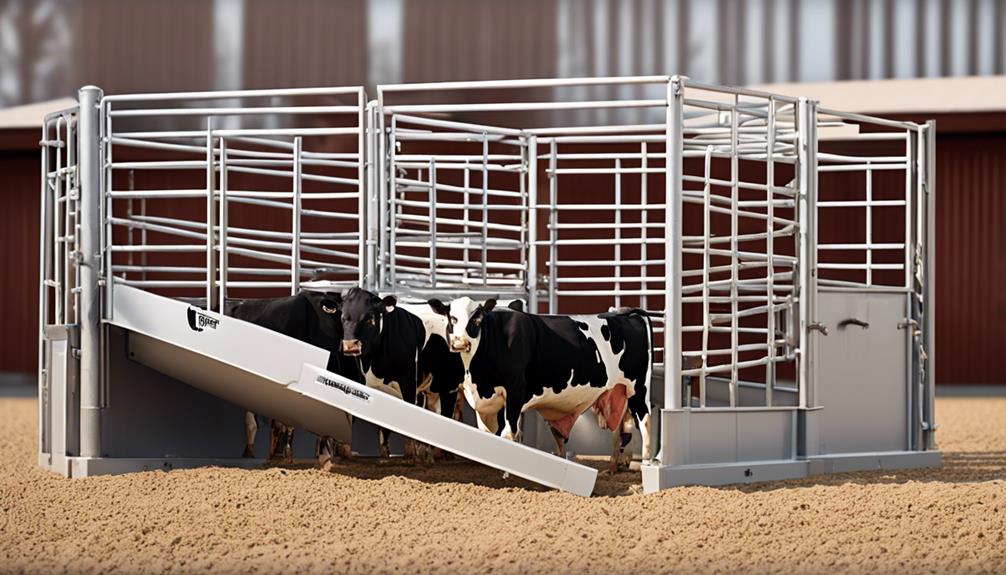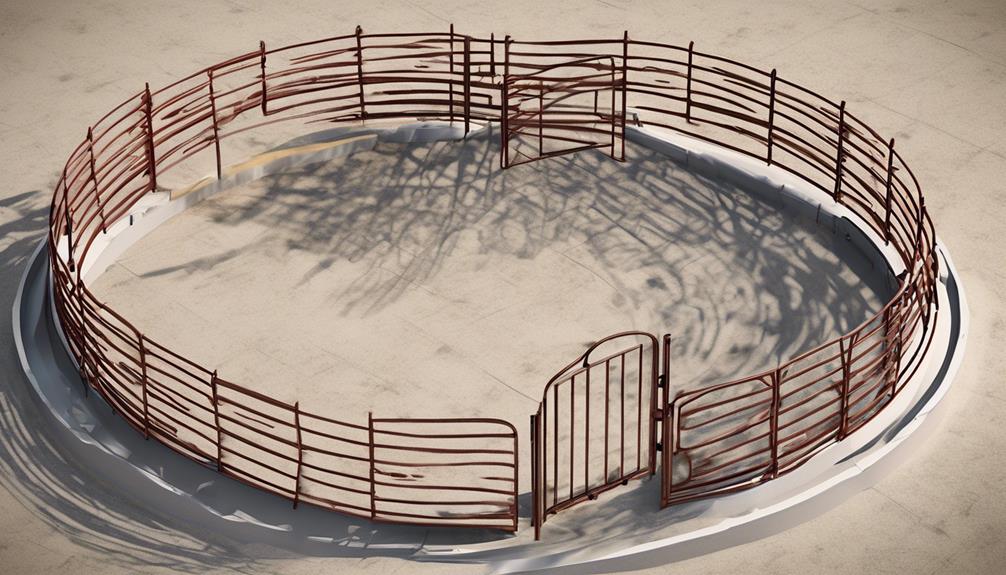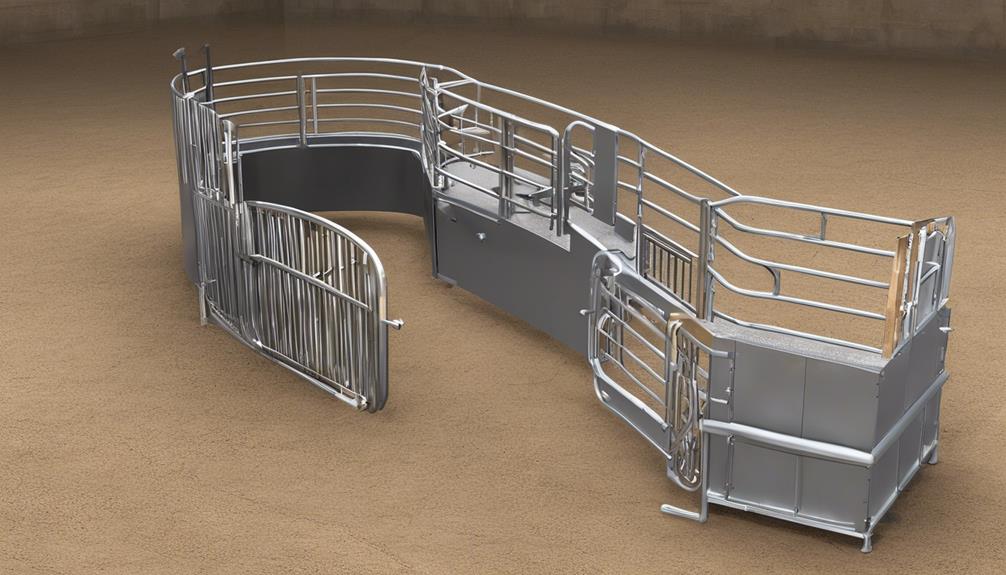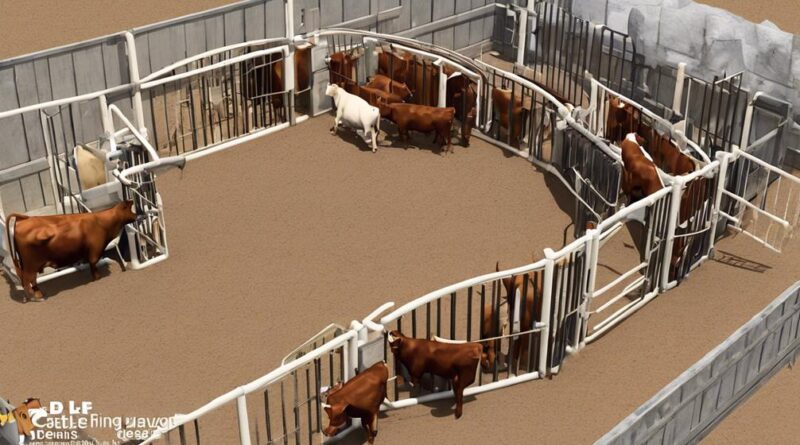10 Best Cattle Chute Layout Designs for Efficient Cattle Handling
When it comes to designing cattle chute layouts, it's like crafting a well-oiled machine for the efficient handling of your livestock.
A smooth and effective cattle handling system can make all the difference in your operation, ensuring the safety of both the animals and the handlers.
But with so many options out there, how do you know which design will truly optimize your workflow and minimize stress for your cattle?
Let's explore the top 10 cattle chute layout designs that are revolutionizing the way farmers and ranchers handle their herds.
Straight Single File Chute

When designing a straight single file chute for cattle handling, consider incorporating curved sides to facilitate a smooth and controlled flow of cattle through the chute. Cattle are sensitive to their surroundings, and the design of the chute can greatly influence their behavior. The curved sides help reduce the feeling of confinement for the cattle. This is important because when cattle feel less stressed and confined, they're more likely to move through the chute in an efficient manner. It's essential to understand cattle behavior and their natural instincts when designing the chute layout.
By incorporating curved sides, you're effectively working with the cattle's instincts, rather than against them.
Efficient flow is crucial in cattle handling, and the layout of the chute plays a significant role in achieving this. The curved sides not only facilitate a smoother flow but also help in reducing the likelihood of cattle becoming agitated or hesitant. When cattle are stressed or agitated, they're more likely to exhibit unpredictable behavior, which can impede the flow through the chute. Therefore, the design should aim to create an environment that encourages calm and steady movement.
Curved Cattle Chute
To design an efficient curved cattle chute, consider incorporating gradual curves to promote smooth and steady movement for the cattle. The benefits of a curved design include reduced stress on the animals as they can't see what's ahead, which helps keep them calm and makes handling easier. The curved layout also allows for better flow and prevents cattle from turning back or stopping abruptly, which can happen in a straight chute. Additionally, the curved design can save space by fitting into odd-shaped areas and utilizing corners more effectively. This space utilization is especially helpful for smaller operations or when retrofitting existing facilities.
However, there are also challenges to consider when implementing a curved cattle chute. One challenge is ensuring that the curves aren't too sharp, as this can cause congestion and stress for the cattle. It's important to find the right balance between smooth curves and maintaining space utilization. Ergonomics also play a crucial role in the design of a curved cattle chute. The layout should be designed to allow handlers to work efficiently and safely, with easy access to all areas for sorting, vaccinating, or performing other necessary tasks.
Circular Crowd Pen Design

Considering the efficient movement and reduced stress benefits of a curved cattle chute, the circular crowd pen design complements this layout by providing a controlled area for gathering and sorting cattle. The circular crowd pen is strategically designed to work with cattle behavior, allowing for efficient animal movement and handling. This layout takes advantage of the natural tendency of cattle to move in a circular pattern.
The crowd pen layout is carefully crafted to minimize stress on the animals and maximize the efficiency of cattle handling. The circular design encourages a continuous flow of cattle, as they're naturally inclined to move in circles, making it easier to guide them through the sorting and loading processes. This design reduces the need for sharp turns or abrupt changes in direction, which can agitate the animals and impede their movement.
Additionally, the circular crowd pen design allows for better visibility and control of the cattle. This layout enables handlers to easily observe the animals from a central vantage point, ensuring that they can effectively guide the cattle through the sorting and loading processes. The controlled environment provided by the circular crowd pen enhances safety for both the animals and the handlers, as it minimizes the risk of injury or escape.
Split Alleys and Crowding Areas
Optimizing cattle movement and minimizing stress, efficient handling is achieved through well-designed split alleys and crowding areas. Split alleys are essential for directing cattle into the desired direction without causing congestion or stress. By providing clear pathways, efficient movement of cattle is ensured, reducing the time and effort required for handling. Safety measures such as non-slip flooring and solid barriers are crucial in these areas to prevent injuries and ensure the well-being of both the cattle and handlers.
When designing split alleys and crowding areas, it's important to consider the natural behavior of cattle. Creating a curved or angled design can help reduce stress as it prevents the cattle from seeing the end of the alley, which can cause anxiety and reluctance to move forward. Additionally, incorporating proper lighting and minimizing loud noises can further contribute to a calm and efficient cattle movement.
In the crowding areas, the layout should facilitate the easy flow of cattle towards the chute or sorting area. Utilizing curved fences and gradual narrowing of the space can encourage the cattle to move forward while preventing overcrowding and potential injuries. It's also important to have strategically placed gates or panels that allow for easy access to individual animals when needed, without disrupting the flow of the group.
Efficient movement and safety measures go hand in hand in the design of split alleys and crowding areas, ensuring that cattle handling operations are conducted smoothly and without causing unnecessary stress to the animals.
Tapered Chute Design

The tapered chute design enhances cattle handling efficiency by facilitating smooth and controlled movement towards the desired destination. This design takes advantage of cattle behavior, as it utilizes the natural inclination of cattle to move from a wider space to a narrower one. As cattle move through the tapered chute, their focus is drawn forward, reducing the likelihood of distractions or hesitations that can impede progress. This efficient movement not only saves time but also minimizes stress on the animals.
When constructing a tapered chute, it's crucial to consider the principles of animal welfare. The chute should be designed to avoid causing injury or unnecessary stress to the cattle. Smooth, curved walls help guide the animals gently without causing them to panic or feel confined. Additionally, non-slip flooring is essential to ensure that the cattle have secure footing as they move through the chute. By prioritizing the comfort and safety of the animals, the tapered chute contributes to efficient handling while maintaining high standards of animal welfare.
Overhead Restraining System
To enhance cattle handling efficiency, consider implementing an overhead restraining system to securely hold the animals in place during necessary procedures. An overhead restraining system offers several benefits that contribute to the overall effectiveness of cattle handling.
It not only ensures the safety of both the cattle and the handlers but also helps minimize stress on the animals during various management practices. When considering the design of your cattle chute layout, incorporating an overhead restraining system can significantly improve your operations.
- Improved Safety: The overhead restraining system provides a secure and stable environment for the animals, reducing the risk of injury to both the cattle and the handlers.
- Reduced Stress: By securely holding the animals in place, the overhead restraint minimizes the stress experienced by the cattle during procedures such as vaccinations, hoof trimming, or pregnancy checks.
- Enhanced Workflow: With the cattle securely restrained, handlers can efficiently and safely carry out necessary tasks, ultimately improving the overall workflow.
- Better Animal Welfare: Prioritizing the well-being of the cattle, the overhead restraining system aligns with animal welfare considerations, ensuring a humane and respectful approach to cattle handling.
- Minimized Escape Risk: The overhead restraint system helps prevent cattle from escaping or exhibiting unpredictable behavior, creating a safer environment for both the animals and the handlers.
Adjustable Alleyways

Consider incorporating adjustable alleyways into your cattle chute layout to optimize the handling process and accommodate varying sizes of cattle. Adjustable alleyways offer customizable configurations, allowing you to create an ergonomic design that suits your specific needs.
With the ability to adjust the width of the alleyways, you can efficiently handle different sizes of cattle without causing unnecessary stress or discomfort to the animals.
These alleyways are designed to promote efficient flow, ensuring that cattle can move through the chute system smoothly and without impediment. By adjusting the width of the alleyways, you can create a more comfortable and secure environment for the cattle, reducing their anxiety and making the handling process safer for both the animals and the handlers.
The ergonomic design of adjustable alleyways also benefits the handlers by providing them with a more user-friendly environment. The ability to customize the layout of the alleyways allows for a more efficient and organized workflow, enabling handlers to easily access and manage the cattle as they move through the chute system.
Dual-Exit Chute System
For efficient cattle handling, incorporating a dual-exit chute system can streamline the process and improve overall productivity. This layout design allows for simultaneous entry and exit of cattle, reducing waiting times and enabling a continuous flow of animals through the handling facility.
The efficiency advantages of a dual-exit chute system are evident in the following ways:
- Reduced Congestion: With two exit points, cattle are less likely to bunch up, reducing stress and potential injuries during the handling process.
- Faster Throughput: The ability to release animals from two exits simultaneously allows for a quicker turnaround between cattle, increasing the overall handling capacity.
- Improved Sorting: Cattle can be sorted more efficiently as they've separate routes for different groups, enhancing the overall management of the herd.
- Enhanced Safety: The dual-exit system provides an alternative route for animals that may become agitated or uncooperative, minimizing the risk of accidents for both the cattle and handlers.
- Optimized Workflow: Handlers can work more efficiently as they can manage cattle from both exits, reducing the time and effort required to maneuver the animals through the chute system.
When implementing a dual-exit chute system, safety considerations remain paramount. Ensuring that both exits are equipped with secure and easily operable gates is essential to prevent cattle from escaping prematurely or causing obstructions. Additionally, maintaining clear visibility and unobstructed pathways around the exits is crucial for the safe and effective movement of animals.
Frequently Asked Questions
What Are the Common Mistakes to Avoid When Designing a Cattle Chute Layout?
When designing a cattle chute layout, avoid common mistakes like overcrowding, sharp turns, and inadequate lighting. These design pitfalls can cause stress and injury to the cattle. Instead, focus on innovative solutions and practical applications for efficient handling.
How Can Weather Conditions Affect the Efficiency of Different Cattle Chute Designs?
Weather conditions can significantly impact cattle chute efficiency. High temperatures can stress cattle, affecting their movement. Strong winds may cause disturbance, while precipitation can make the ground slippery, affecting cattle handling. Consider these factors when designing chute layouts.
Are There Any Specific Safety Considerations to Keep in Mind When Using a Dual-Exit Chute System?
When using a dual-exit cattle chute, specific safety precautions are crucial for efficient cattle handling. Consider cattle behavior, potential escape routes, and proper chute layout design to ensure safe and effective livestock management.
What Are the Key Factors to Consider When Choosing Between a Curved Cattle Chute and a Straight Single File Chute?
When choosing between a curved cattle chute and a straight single file chute, consider the pros and cons of each in terms of efficiency and safety. Evaluate the space requirements for both layouts to determine the best fit for your operation.
How Can Technology Be Integrated Into Cattle Chute Designs to Improve Efficiency and Handling?
To improve efficiency and handling, integrate technology into cattle chute designs. Use data analysis to understand cattle behavior, optimizing efficiency. Incorporate automated sorting and weighing systems for streamlined operations, making cattle handling more effective.
Conclusion
In conclusion, these 10 cattle chute layout designs offer efficient and safe handling for cattle. Whether using a straight single file chute or a circular crowd pen design, each layout has its own benefits for minimizing stress on the animals and maximizing efficiency for handlers.
By considering the specific needs of your operation and the behavior of cattle, you can choose the best layout to improve your cattle handling practices.
